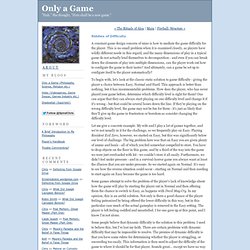

The Case for Casual Biometrics. Lecturer and developer Stefano Gualeni explains how his team employed biometric testing -- once the purview of big publishers and chiefly used to test action games -- to improve player response to a casual, indie iOS game.

"For the most part, the English and American whale draughtsmen seem entirely content with presenting the mechanical outline of things, such as the vacant profile of the whale; which, so far as picturesqueness of effect is concerned, is about tantamount to sketching the profile of a pyramid. " Herman Melville, Moby Dick; or, The Whale, Chapter LVI - Of the Less Erroneous Pictures of Whales, and the True Pictures of Whaling Scenes. This article charts the history of a whale. The Case for Casual Biometrics. Ben Ruiz's Blog - The Skill Divisions Of Combat-Heavy Game Players. The following blog post, unless otherwise noted, was written by a member of Gamasutra’s community.

Measurement Techniques For Game Designers. Irrational Play and Design. Introduction Dan Ariely’s 2009 Ted Talks have accumulated over 3 million views.

They captured my imagination and compelled me to read (and love) his book Predictably Irrational. So in early 2013 when I saw that he was teaching an online class through coursera.org, I registered without hesitation. After two weeks of class, I decided to write up how these lessons relate to my experience as a game designer. Researchers Explain How Brands Make You Fall In Love. Brands spend millions of dollars trying to make consumers fall in love with them, and according to C.W.

Park, director of the Global Branding Center at USC’s Marshall School of Business, these attempts are usually miserable failures. "If you really ask people, they have only vague understandings about each brand," says Park. "Or they’re not aware of many brands in the first place. " Park realized that he felt close to some brands—like the Pittsburgh Steelers. Riddles of Difficulty. A constant game design concern of mine is how to mediate the game difficulty for the player.

This is no small problem when it is examined closely, as players have wildly different needs in this regard, and the many dimensions of play in a typical game do not actually lend themselves to decomposition - and even if you can break down the elements of play into multiple dimensions, can the player work out how to configure the game to their tastes? And ultimately, can a game be set up to configure itself to the player automatically? To begin with, let's look at the classic static solution to game difficulty - giving the player a choice between Easy, Normal and Hard. This approach is better than nothing, but it has insurmountable problems. Myers-Briggs Personality Types. Play This Game, Get That Job. Illustration: L-Dopa The first time I played Balloon Brigade, I got whaled on so hard that I could feel my future job prospects evaporating.

That’s because the mobile game, which hits the App Store in July, is part of a wave of career-aptitude analyses being offered by Knack. onlyagame.typepad.com/Player%20Typology.digra2011.pdf. Emotions of Play Revisited. Nicole Lazzaro's Blog. Emotion and the Fun of Games As experts in player experiences we see a huge gap between “market research” and what players most enjoy about play.

Players may check “good graphics” on a online survey, but our cross-genre contextual research reveals a more interesting story. We know how games deliver more emotions than frustration, excitement, and fear. The secret is in the gameplay. The 4 Fun Keys create games’ four most important emotions 1. Hard Fun: Fiero – in the moment personal triumph over adversity 2. These four main reasons why people play games are how best sellers create more emotions for more captivating play. Dan Bress's Blog - Player Types: The Challenge Model. The following blog post, unless otherwise noted, was written by a member of Gamasutra’s community.

The thoughts and opinions expressed are those of the writer and not Gamasutra or its parent company. This is part of an ongoing series of articles on Player Types in "A" list Massives aimed at the American and European market, such as EverQuest®, Dark Age of Camelot®, World of Warcraft®, Lord of the Rings Online®, Eve Online®, Warhammer Online®, etc. My first goal over the next few months is to develop a comprehensive list and description of unique player types. To accomplish this I will need your input and observations. ---- Massive Multiplayer Online Games aka Massives This discussion involves Massive Online GAMES. People may choose to experience a Virtual World such as Second Life or they may choose to play a Massively Multiplayer Online Game that is conducted in a Virtual World, such as World of Warcraft. ---- Previous Works Player Types & The Challenge Model 1.
People play games to win. Player Types (from Robin D. Laws) International Hobo - DGD1 Questionnaire - What Play Style Do You Prefer? - The Results. Type 1: Conqueror This play style is associated with challenge and the emotional payoff of Fiero - triumph over adversity (the feeling that makes you put both arms in the air, like when your sports team scores).

This play style is highly patient with frustration, because they know if they stick with it, they can win. Players who prefer this play style often aim to utterly defeat games they play - and they tend to finish games they start. Proficiency with logistical optimisation (improving through playing the same challenge again and again) and strategic thinking are the main skills of many players preferring this play style. Type 2: Manager. Personality And Play Styles: A Unified Model.
Personality And Play Styles: A Unified Model By Bart Stewart [In this comprehensive analysis, multiple psychological systems of gameplay are surveyed, to try and arrive at a unified model in which player behavior can be understood and, crucially for game developers, catered to.]

Numerous models of gamer psychology have been proposed and debated over the past couple of decades.